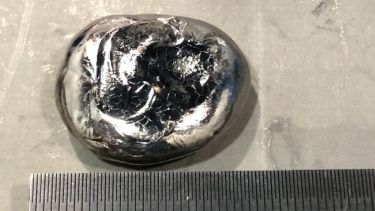Investigating the Effect of Helium Fusion Plasmas on the Microstructure and Thermomechanical Properties of Tungsten-Tantalum Alloys
Researchers utilised the Royce Discovery Centre facilities, to produce tungsten-tantalum alloys in complete solid solution using a novel processing method.
CONTEXT
Through the Royce Student Equipment Access Scheme, Emre Yildirim, a Postgraduate Researcher at the Materials Performance Centre, The University of Manchester, accessed the Arcast 200 Arc Melter situated in the Royce Discovery Centre.
The Royce Student Equipment Access Scheme provides funding for research students to utilise equipment and learn new techniques to support their testing.
Expertise to identify the equipment and techniques which would benefit research carried out by Emre were provided by Royce Research Associate, Dr. Yunus Azakli, The University of Sheffield.
PROJECT SUMMARY
Initially weighed and cleaned at The University of Manchester, alloys of tungsten-tantalum, of weight percentage W-5%Ta and W-10%Ta in 3 buttons of 3.5cm2, were melted at the Royce Discovery Centre, using the Arcast 200 Arc Melter.
These buttons will be integral to experimental studies. The components will be exposed to helium plasmas and utilised in ion irradiation studies in order to discern the effect of helium fusion plasmas on the microstructure and thermomechanical properties of tungsten-tantalum alloys.
FURTHER RESEARCH
Further measurements of the induced microstructural changes will be taken through Scanning Electron Microscopy (SEM) and Transmission Electron Microscopy (TEM). Measurements of the thermomechanical properties, before and after the experiments, will be taken using transient grating spectroscopy.
These will be further modelled through molecular dynamics simulation in order to understand why these changes occur upon the addition of tantalum to a tungsten matrix.
The desired outcome is to determine that the tantalum, which has been shown to mitigate other issues induced by a fusion environment [such as the segregation of transmutation products], will also act to inhibit some of the changes in thermomechancial properties induced by radiation damage.
These samples will form the centrepiece of the experiments carried out throughout the duration of the project, and will have a huge impact on this research.
The Royce Student Equipment Access Scheme has been integral to my project. Producing good samples is essential when working with materials, such as tungsten, as extreme environments are required to melt and mould it.
The Arc Melter at the Royce Discovery Centre was the optimal route to processing refractory metal alloys of tungsten. The plethora of processing equipment present at The University of Sheffield is invaluable.Emre Yidirim
Postgraduate Researcher | The University of Manchester
ABOUT THE EQUIPMENT
The Arcast 200 Vacuum Arc Melting Furnace is a tool for research and prototype production.
It offers the ability to melt, cast, and rapidly solidify metal alloys of nominal 200g mass using a clean, ceramic free cold crucible process.
It has the ability to melt and alloy metals at over 3000°C, such as titanium alloys, shape memory alloys, amorphous alloys, and high entropy alloys.


